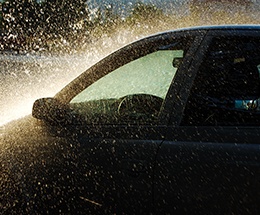 Spring has officially arrived! While many people breathe a sigh of relief because winter driving has ended, spring driving can also pose dangerous situations. It’s important to understand that each season change brings different driving conditions.
Spring has officially arrived! While many people breathe a sigh of relief because winter driving has ended, spring driving can also pose dangerous situations. It’s important to understand that each season change brings different driving conditions.
Here are some tips to keep you and your family safe on the roads this spring.
1. Be on the lookout for potholes.
Extreme winter weather takes a toll on our roadways, creating large potholes. Heavy rain can fill them with water making them difficult to see. These monsters can damage your car leading to expensive repairs. Damages can include:
- Punctured tires;
- Bent rims;
- Suspension damage;
- Poor alignment; and
- Exhaust system damage.
Keep a safe following distance in case the driver in front of you reacts. Never swerve to avoid a pothole. This can put you and your family in a more dangerous situation. Gently brake before it if you can.
2. Slow down for spring showers.
Did you know that roads are the most slippery when it first begins to rain? This is caused by the rainwater mixing with contaminants on the road, such as oil and grease. Make sure to increase your following distance to allow for proper braking.
3. Watch for animals on the move.
Animal activity increases during the spring. For some, this is mating season and for others, they’re waking up from their long winter slumber. Remember, deer are most active at dawn and dusk.
4. Watch for pedestrians on the move.
As temperatures increase, more people are outside walking or bicycling with their families. Slow down in your neighborhood and pay extra attention at crosswalks. If pedestrians have the walk signal, they have the right of way.
5. Share the road with motorcycles.
Because of their speed and size, motorcycles may quickly come in and out of your blind spots. Always take a second look now that motorcycles are out on the road. In addition, be courteous. Motorcycles have the same right to be on the road. If you end up following a motorcycle, maintain a safe following distance of at least four seconds.
6. Maintain proper tire air pressure.
During the winter months, tires lose air due to the cold temperatures, causing tires to be underinflated. Warmer temperatures can cause tires to be overinflated. Each situation can lead to increased wear and poor handling.
7. Inspect your tires.
Adequate tire tread is important for wet weather driving. Tire tread actually moves water away from the tires. As tire tread wears, less tread means reduced traction. When it comes time for buying new tires don’t focus only on price. Read reviews and recommendations. Remember, you’re relying on a contact patch the size of your hand to keep you and your family safe.
8. Pay attention in construction zones.
When driving through construction zones, follow these tips.
- Be attentive. Construction workers and equipment may suddenly enter the roadway. Traffic patterns can change daily to accommodate the work being done.
- Understand and follow the signs.
- Make safe lane changes. Solid lines in construction zones mean that you should stay in your lane.
- Slow down. Fines may be doubled in construction zones. In addition, slowing down can save a life.
For additional information on safe driving, check out the blogs below.
Eleven tips to avoid or handle hydroplaning
Essential safety tips for sharing the road with motorcycles
Road America and West Bend Keep Teen Drivers Safe
As a motorist, do you understand biking laws?
Six tips for keeping your tires in shape so you can be safe
Do you have any suggestions or information you’d like to share? I’d love to hear from you. Please share them in the box below.





